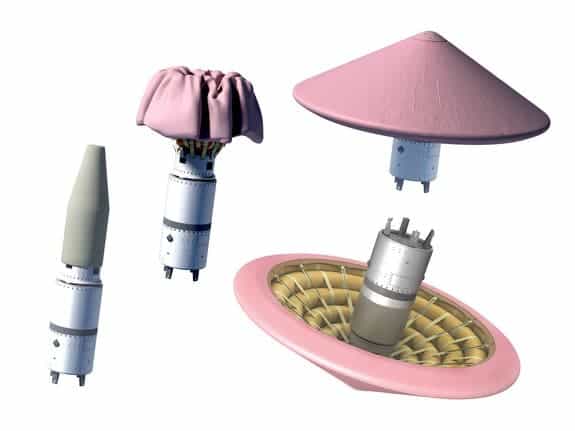For the past couple of years NASA has been testing a new atmospheric re-entry system, designed to offer pods and capsules more stability and better degree of safety upon re-entering Earth’s atmosphere. Just yesterday, the latest, the Inflatable Reentry Vehicle Experiment (IRVE-3), was launched from NASA’s Wallops Flight Facility on Wallops Island, Virginia for its 20-minute test, which underwent point-on-point according to plan.
The Inflatable Reentry system is not just a space balloon. The intricate technology is comprised of a cone made up of inflatable rings that are wrapped in layers of high-tech thermal blankets to protect it, and more importantly the capsule, from the searing heat of re-entry through Earth’s atmosphere. About six minutes into the flight, as planned, the 680-pound inflatable heat shield, and its payload separated from the launch vehicle’s nose cone, about 280 miles over the Atlantic Ocean.

Four cameras were attached aboard the IRVE-3 prototype, which recorded the launch’s progress, as well as the capsule’s plunge back to Earth. Instruments measured re-entry forces of around 20 Gs or 20 times the force of Earth’s gravity, during the capsule’s hypersonic speed of up to 6,000 mph (9,656 kph), along with temperatures over 1,000 degrees Fahrenheit (537 degrees Celsius).
“We had a really great flight today,” James Reuther, deputy director of NASA’s Space Technology Program, told reporters in a news briefing Monday (July 23). “Initial indications are we got good data. Everything performed as well, or better, than expected.”
While the system was perfectly demonstrated on Earth, the final goal of the re-entry technology is Mars. The atmosphere is much thinner there, but the necessary mass required for such a far away from home missions would also be impressive. Thus, an atmospheric entry system that is as light as possible, without hindering sheltering capabilities becomes quite appealing.
“As far as the applicability of the technology, [we were] originally motivated to do this to allow us to potentially land more masses at Mars,” said Neil Cheatwood, IRVE-3 principal investigator at Langley Research Center. “Mars is a very challenging destination. It has a very thin atmosphere — too much of an atmosphere to ignore, but not enough for us to do the things we would at other planets. That was our motivation about nine years ago when we started doing this stuff.”
The new test is a follow-on to the successful IRVE-2, which showed an inflatable heat shield could survive intact after coming through Earth’s atmosphere. IRVE-3 was the same size as IRVE-2, but had a heavier payload and was subjected to a much higher re-entry heat, similar to what a heat shield might encounter in space.
“It’s great to see the initial results indicate we had a successful test of the hypersonic inflatable aerodynamic decelerator,” said James Reuther, deputy director of NASA’s Space Technology Program. “This demonstration flight goes a long way toward showing the value of these technologies to serve as atmospheric entry heat shields for future space.”






